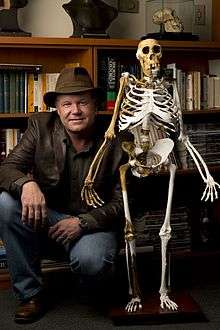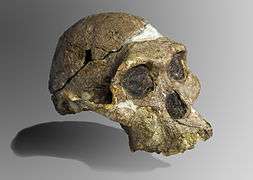Lee Rogers Berger
Lee Rogers Berger (born December 22, 1965) is an American-born South African paleoanthropologist and National Geographic Explorer-in-Residence.[1][2][3] He is best known for his discovery of the Australopithecus sediba type site, Malapa;[4] his leadership of Rising Star Expedition in the excavation of Homo naledi at Rising Star Cave;[5] and the Taung Bird of Prey Hypothesis.[6][7]
Lee R. Berger | |
|---|---|
 Lee R. Berger with reconstruction of Au. sediba | |
| Born | December 22, 1965 Shawnee Mission, Kansas, U.S. |
| Alma mater | |
| Spouse(s) | Jacqueline Berger |
| Children | Megan, Matthew |
| Awards | Time 100, 2016 - most influential people in the American world |
| Scientific career | |
| Fields | Paleoanthropologist and National Geographic Explorer-in-Residence |
| Institutions | University of the Witwatersrand |
| Thesis | Functional morphology of the hominoid shoulder, past and present. (1994) |
| Doctoral advisor | Phillip V. Tobias |
| Website | www |
Berger is known not only for his discoveries, but also for his unusually public persona in paleoanthropology, and for making his most notable discoveries open-access projects. He makes hundreds of talks per year, and has had a close relationship with National Geographic for many years, appearing in several of their shows and documentaries.[8]
Early life and education
Berger was born in Shawnee Mission, Kansas in 1965, but was raised outside of Sylvania, Georgia in the United States.[9][10] As a youth, Berger was active in the Boy Scouts, Future Farmers of America, and president of Georgia 4-H. In 1984, Berger was named Georgia's Youth Conservationist of the Year for his work in conserving the threatened gopher tortoise. He is a Distinguished Eagle Scout, and received the Boy Scouts of America Honor Medal for saving a life in 1987.[11][12]
He graduated from Georgia Southern University in 1989 with a degree in anthropology/archaeology and a minor in geology.
He undertook doctoral studies in palaeoanthropology at the University of the Witwatersrand (Wits) in South Africa under Professor Phillip Tobias, focusing his research on the shoulder girdle of early hominins; he graduated in 1994. In 1991, he began his long term work at the Gladysvale site. This marked the same year that his team discovered the first early hominin remains from the site, making Gladysvale the first new early hominin site to be discovered in South Africa since 1948.[13] In 1993, he was appointed to the position of research officer in the Paleo-Anthropology Research Unit (PARU) (now the Evolutionary Sciences Institute; ESI) at Wits.
Research career
He became a postdoctoral research fellow and research officer at the University of the Witwatersrand in 1995. He has been the leader of the Palaeoanthropology Research Group and has taken charge of fossil hominin excavations, including Sterkfontein, Swartkrans, and Gladysvale. In 2004, he was promoted to Reader in Human Evolution and the Public Understanding of Science. He is presently a research professor in the same topic at the Evolutionary Studies Institute (ESI) and the Centre of Excellence in Palaeosciences (CoE Pal) at Wits.
Research and other activities
Organizational offices
Berger served as Executive Officer of the Palaeo-Anthropological Scientific Trust (PAST) (now the Palaeontological Scientific Trust; PAST) from 1994 to 2001.[14][15] Berger served on the committee for successful application for World Heritage Site Status for the UNESCO Sterkfontein, Swartkans, Kromdraai, and Environs site. He also served on the Makapansgat site development committee, as well as the committee for both Makapansgat and Taung's application for World Heritage site status.[16] He was also a founding Trustee of the Jane Goodall Trust South Africa.[17]
Berger served with the Royal Society of South Africa, Northern Branch, between 1996 and 1998, and served as Secretary in 1996 and 1997. He also served on the Fulbright Commission, South Africa, chairing it in 2005, and chairing its Program Review Committee from 2002 to 2004.[17]
Berger is a Fellow of the Royal Society of South Africa and serves on the Senior Advisory Board of the Global Young Academy. In 1997 he was appointed to an adjunct professorial position in the Department of Biological Anthropology and Anatomy at Duke University in Durham North Carolina and the following year as an honorary assistant professor in the Department of Anthropology at the University of Arkansas.
Specific study results
Palau fossils
Berger was lead author of a controversial report of the discovery in 2006 of what he and colleagues claimed were small-bodied humans in Palau, Micronesia.[18][19][20] Scholars have disputed the argument that these individuals are pygmoid in stature, or that they were the result of insular dwarfism;[19][21] in an article titled "Small Scattered Fragments Do Not a Dwarf Make", anthropologists Scott M. Fitzpatrick (NC State), Greg C. Nelson (University of Oregon), and Geoffrey Clark (Australian National University) conclude that "[p]rehistoric Palauan populations were normal-sized and exhibit traits that fall within the normal variation for Homo sapiens," hence, concluding that their evidence did "not support the claims by Berger et al. (2008) that there were smaller-bodied populations living in Palau or that insular dwarfism took place"[22] Berger and co-authors Churchill and De Klerk replied to the study, saying "the logical flaws and misrepresentations in Fitzpatrick and coworker's paper are too numerous to discuss in detail" and that their restudy report "amounts to a vacuous argument from authority... and ad hominem assault, and brings little new data to bear on the question of body size and skeletal morphology in early Palauans".[23] John Hawks, the paleoanthropologist who edited the original Palau article for PLoS ONE, has replied in part to some of the dissenting researchers' claims (in his personal web blog).[24]
Discovery of Australopithecus sediba
In August 2008, 9-year-old Matthew Berger, the son of Lee Rogers Berger, found a clavicle and a jawbone embedded in a rock near Malapa Cave in South Africa.[25] Subsequent excavation, headed by Berger, led to the discovery of numerous bones nearby that dated back nearly two million years. Along with various co-authors, Berger published a series of articles between 2010 and 2013 in the journal Science that describe what they call a new species, Australopithecus sediba, which had a mixture of primitive and modern characteristics. The finding was particularly promising because it potentially revealed a previously unknown transitional species between the more ape-like australopithecines and the more human-like Homo habilis.[26][27] Berger claimed that this new finding represented "the most probable ancestor" of modern-day Homo sapiens.[8]
Berger's work at the Malapa site was significant not only because of the discovery itself, but also because of the way he and his collaborators shared information about their findings. While most paleoanthropological investigations are known for a high level of secrecy, Berger worked to make the sediba site an open access project. In addition to sharing digital data, he made the fossils found available on request to researchers wanting to study them themselves.[28]
Discovery of Homo naledi
On September 13, 2013, two recreational cavers, Rick Hunter and Steven Tucker, discovered a previously unknown, remote chamber within the well known Rising Star cave system. Discovering the floor of this chamber (now known as the Dinaledi Chamber or UW-101) littered with human-like bones, the pair reported their finds to a colleague, who in turn brought them to the attention of Berger. Recognizing their importance, and unable to access the chamber himself due to his size, Berger organized an expedition over social media that brought six qualified researchers in from around the world to commence an excavation of the remains in November 2013.[29] An early career workshop was organized in May 2014 that brought together 54 local and international scientists to describe and study the more than 1550 fossils recovered. In September 2015, the team announced Homo naledi as a new hominin species, citing its unique mosaic of more ancestral and human-like traits.[30] Other fossil bearing localities in the system were given the site numbers 102 to 104, though research regarding them has not yet been published.[31]
Awards

Collaborative research papers by Berger have been recognized four times as being among the top 100 Science stories of the year by Discover Magazine, an international periodical focusing on popular scientific issues. The first recognition came in 1995 for his co-authored work with Ron Clarke of Wits on the taphonomy of the Taung site and in 1998 for his co-authored work with Henry McHenry of the University of California, Davis on limb lengths in Australopithecus africanus.
He is a National Press Photographers Association Humanitarian Award winner in 1987 for throwing his camera down while working as a news photographer for television station WTOC and jumping into the Savannah River to save a drowning woman.[26] He is a Golden Plate Awardee of the Academy of Achievement. In 1997, the National Geographic Society in Washington, D.C. awarded him the first National Geographic Society Prize for Research and Exploration given for his research into human evolution.[27] In April 2016, Berger was selected by Time as one of its "100 most influential people".[32]
Personal life
Berger has resided in South Africa since 1989. His wife Jacqueline is a radiologist in the medical school at the University of the Witwatersrand, the same university where he works.[33] They have a son, Matthew,[33] and a daughter, Megan.
Selected publications
Over one hundred scientific and popular articles including several books:
Articles
- Berger, Lee R.; et al. (2015). "Homo naledi, a new species of the genus Homo from the Dinaledi Chamber, South Africa". eLife. 4. doi:10.7554/eLife.09560. PMC 4559886. PMID 26354291. Lay summary.
- Berger, L. R.; de Ruiter, D. J.; Churchill, S. E.; Schmid, P.; Carlson, K. J.; Dirks, P. H. G. M.; Kibii, J. M. (2010). "Australopithecus sediba: a new species of Homo-like australopith from South Africa". Science. 328 (5975): 195–204. Bibcode:2010Sci...328..195B. CiteSeerX 10.1.1.729.7802. doi:10.1126/science.1184944. PMID 20378811.
Books
- Redrawing the family tree? (National Geographic Press, 1998)
- Visions of the Past (Vision. End. Wild. Trust, 1999)
- Towards Gondwana Alive: promoting biodiversity and stemming the sixth extinction (Gondwana Alive Soc. Press, 1999)
- In The Footsteps of Eve[10] (with Brett Hilton-Barber) (National Geographic, 2001)
- The Official Field Guide to the Cradle of Humankind, with Brett Hilton-Barber (Struik, 2002). For a review, visit
- Change Starts in Africa (in South Africa the Good News) (S.A. Good News Publishing, 2002)
- Working and Guiding in the Cradle of Humankind (Prime Origins Publishing and The South African National Lottery, 2005)
- Berger, Lee; Hilton-Barber, Brett (2002). The Official Field Guide to the Cradle of Humankind: Sterkfontein, Swartkrans, Kromdraai and Environs World Heritage Site. Cape Town: Struik Publishers. ISBN 978-1868727391.
- The Concise Guide to Kruger (Struik, 2007)
- Berger, Lee; Aronson, Marc Aronson (2012). The Skull in the Rock: How a Scientist, a Boy, and Google Earth Opened a New Window on Human Origins. National Geographic Society. ISBN 978-1426310539.
- Berger, Lee; Hawks, John (2017). Almost Human: The Astonishing Tale of Homo naledi and the Discovery That Changed Our Human Story. Washington: National Geographic Society. ISBN 978-1-4262-1811-8.
See also
- Dawn of Humanity (2015 PBS film)
- Footprints of Eve
References
- "Biography: Lee Berger". University of the Witwatersrand, Johannesburg. Retrieved May 16, 2016.
- "Lee R. Berger, Ph.D. Biography and Interview". www.achievement.org. American Academy of Achievement.
- "Lee Berger". National Geographic. Retrieved May 16, 2016.
- Lloyd, Julia. "Malapa Cave: Australopithecus Sediba's Place of Discovery". Maropeng. Retrieved May 16, 2016.
- mmagnan1 (January 22, 2014). "News on South Africa's Hominins: Berger's Rising Star Expedition". Anthropology.net. Retrieved May 16, 2016.
- Berger, LR; Clarke, RJ (1995). "Eagle involvement in accumulation of the Taung child fauna" (PDF). Journal of Human Evolution. 29 (3): 275; 299. doi:10.1006/jhev.1995.1060. Archived from the original (PDF) on September 24, 2015.
- Davie, Lucille. "Who killed the Taung child?". SouthAfrica.info. Archived from the original on March 10, 2016. Retrieved May 16, 2016.
- Williams, Paige. "The Big Fight Over Fossils". The New Yorker. Retrieved June 28, 2016.
- "Lee Berger | South African paleoanthropologist". Encyclopædia Britannica. Retrieved May 25, 2016.
- Bascomb, Bobby (September 10, 2015). "Archaeology's Disputed Genius". Nova Next.
- "Lee Berger, headline-making scientist, is an Eagle Scout". Bryan on Scouting. September 10, 2015. Retrieved May 25, 2016.
- Berger, Lee R.; Aronson, Marc (2012). The Skull in the Rock: How a Scientist, a Boy, and Google Earth Opened a New Window on Human Origins. Washington, D.C.: National Geographic Society. pp. 13–19. ISBN 978-1-4263-1010-2.
- Berger, Lee R.; Keyser, André W.; Tobias, Phillip V. (September 1, 1993). "Gladysvale: First early hominid site discovered in South Africa since 1948". American Journal of Physical Anthropology. 92 (1): 107–111. doi:10.1002/ajpa.1330920109. ISSN 1096-8644. PMID 8238287.
- Brain, CK (2003). "A perspective on the PAST". South African Journal of Science. 99: 235–236.
- Blumenschine, RJ; Leenen, A (2016). "What's new from the PAST?" (PDF). South African Journal of Science. 112: 7–9. doi:10.17159/sajs.2016/a0139. Retrieved May 25, 2016.
- "Fossil Hominid Sites of South Africa". UNESCO. Retrieved May 25, 2016.
- "Rising star". University of the Witwatersrand, Johannesburg. October 26, 2015. Retrieved May 25, 2016.
- Berger, Lee R.; Steven E. Churchill; Bonita De Klerk; Rhonda L. Quinn (March 2008). "Small-Bodied Humans from Palau, Micronesia". PLoS ONE. 3 (3): e1780. Bibcode:2008PLoSO...3.1780B. doi:10.1371/journal.pone.0001780. PMC 2268239. PMID 18347737.
- "Ancient Small People on Palau Not Dwarfs, Study Says". National Geographic News. Retrieved May 25, 2016.
- John Noble Wilford (March 11, 2008). "Discovery Challenges Finding of a Separate Human Species". The New York Times. Retrieved September 10, 2015.
- Dalton, Rex (April 16, 2008). "Archaeology: Bones, isles and videotape". News Feature. Nature. 452 (7189): 806–808. Bibcode:2008Natur.452.....D. doi:10.1038/452806a. PMID 18431826.
Subtitle: Old human remains found on the Pacific islands of Palau are caught in the crossfire between entertainment and science. Rex Dalton reports.
- Fitzpatrick, Scott M.; Greg C. Nelson; Geoffrey Clark (August 27, 2008). "Small Scattered Fragments Do Not a Dwarf Make: Biological and Archaeological Data Indicate that Prehistoric Inhabitants of Palau Were Normal Sized". PLoS ONE. 3 (8): e3015. Bibcode:2008PLoSO...3.3015F. doi:10.1371/journal.pone.0003015. PMC 2516174. PMID 18728774.
- Fitzpatrick, Scott M.; Greg C. Nelson; Geoffrey Clark (December 11, 2008). "Reader Comments: The Small-Bodied Early Inhabitants of Palau, comment in response to Small Scattered Fragments Do Not a Dwarf Make: Biological and Archaeological Data Indicate that Prehistoric Inhabitants of Palau Were Normal Sized". PLoS ONE. 3 (12): e3015. Bibcode:2008PLoSO...3.3015F. doi:10.1371/journal.pone.0003015. PMC 2516174. PMID 18728774.
- Hawks, John (March 13, 2008). "john hawks weblog: What about Palau?". Homo erectus, Flores. Retrieved September 10, 2015.
- Maugh II, Thomas H. (April 9, 2010). "2-Million-Year-Old Fossils Offer Look at Human Evolution". News. Los Angeles Times. Retrieved September 10, 2015.
Subtitle: Scientists say the skeletons of a woman and boy could be one of the most important finds of recent times. A discovery by a 9-year-old led to finding the pair, dubbed Australopithecus sediba.
- Walston, Charles (1986). "TV cameraman on story rescues woman in river". State News. The Atlanta Journal (September 19). Atlanta, GA, USA. p. B/1. Archived from the original on September 28, 2007.
- Room, National Geographic Press (August 14, 2013). "Lee Berger, Sarah Parcak Join National Geographic's Explorer Ranks – National Geographic Society Press Room". Retrieved May 25, 2016.
- Wong, Kate. "Could a Renewed Push for Access to Fossil Data Finally Topple Paleoanthropology s Culture of Secrecy?". Retrieved June 28, 2016.
- "This Face Changes the Human Story. But How?". National Geographic News. September 10, 2015. Retrieved July 6, 2016.
- Berger, Lee R.; Hawks, John; Ruiter, Darryl J. de; Churchill, Steven E.; Schmid, Peter; Delezene, Lucas K.; Kivell, Tracy L.; Garvin, Heather M.; Williams, Scott A. (September 10, 2015). "Homo naledi, a new species of the genus Homo from the Dinaledi Chamber, South Africa". eLife. 4: e09560. doi:10.7554/eLife.09560. ISSN 2050-084X. PMC 4559886. PMID 26354291.
- Berger, Lee R. (January 24, 2015). "Annual Report 2014 for the Rising Star Cave and Empire Cave systems" (PDF). SAHRA. Retrieved July 6, 2016.
- Homo naledi scientist cracks Time's 100 most influential people list. April 21, 2016. The South African.
- "Dawn of Humanity", NOVA, PBS (1), September 16, 2015
Further reading
| Wikimedia Commons has media related to Lee Rogers Berger. |
- Berger's Published Curriculum Vitae
- In the Footsteps of Eve, with Brett Hilton-Barber (National Geographic, 2001)
- Paleoanthropology in South Africa, in Citizendium
External links
- National Geographic Outpost
- Fossil Hunter Television Series.
- Explorers Bio, National Geographic Society
- National Geographic blog of Rising Star Expedition members
- National Geographic Live! - Part Ape, Part Human: The Fossils of Malapa
- Lee Rogers Berger on IMDb
- Publications by Lee Rogers Berger, at ResearchGate
- People by Lee R Berger, at SAHRA
